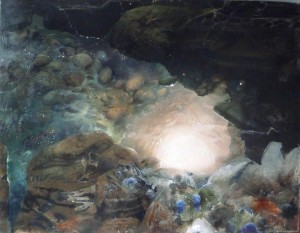The sea of our childhood was the lair of corsairs and pirates; fabulous cargoes, wrecked hulls spitting sheaves of diamonds, bunches of jewels; trunks of goldsmithery corroded by salt, gorged with enamel craft and sequins wriggling in the sunlight filtered by the coldness of water… Hélène Legrand shows the reality of the legend: the true treasure is the sea itself. Every creek, crack and puddle is a safe. It is enough to have a little sun in cold water to see shining stone cabochons, pebbles polished like pearls, a collar of crystal with a broken string releases its bubbles; greens and bluish, some dune thistles are floating like vegetable sea urchins crimped in their bezels of spines. The russet gold patch, in the lower right corner, is not coral but heather desiccated by the summer heat. So we are at the edge of the sea, and the period is not random. The moving surface accommodates time. The calm of the water may be a hint of low tide… However, the moment remains suspended: is this day or night?
“La Hague” invites the watcher to dive through the four elements. Initially the glance crosses a layer of air which is common to him and the picture; we go from the ambient space to the spirit hovering over the waters, carrying heather and thistle. In the upper right corner, a dark rock emerges, like a lid folded back on the translucent veil of the surface where the transient vegetal realm is swimming around. Then, revived by water, small and large pebbles are vying in roundness, softness and (faint) color. A pink ocher hollow, fine sand: we touch the bottom – or do we? Surprised: light oozes from the mud.
Would this be an optical illusion, a case of being moonstruck, an underwater sun, the lamp of a diver? This unnatural irradiation does not occur in a random place: La Hague has been a place of concern since nuclear power took hold there: did it upset the ordering of the world? What is this “here lies”? Dali represented himself as a child “lifting the skin of the sea to observe a dog sleeping in the shade of the water”; Hélène Legrand contemplates a more tragic event.
This is because painting is an invitation to go beyond appearances. What is there behind the inconstancy of forms, the “floating world” of the Japanese? Words, as overly heavy pebbles, roll away before answering. Only a brush can shed all the light and pry out this radiation hidden behind things, beyond representation, almost behind the canvas. A praise of depth, where the true light is inside, this work embodies Victor Hugo’s formula: “form is the bottom which goes back to the surface”. Here is a painting like a manifesto, amalgamating a world vision, an outlook on art, and the destiny of man. Of a man. Of a father.
The danger does not come only from the liquid abyss or from the pirates of the atom. The cliffs of La Hague are sometimes fatal to those with a heavy heart and a stormy soul. This is why the moment remains suspended: beyond day and night, water and light seem to flow from each other, smoothing a clay with carnal hues. In this water hole, soft and fresh like an infant’s skin, a baptism, a touch of grace, is infusing. The true treasure of painting is a first payment in anticipation for a new incarnation of light made flesh or flesh made light. La Hague (the name means enclosure) is not any more the tomb but the cradle of a glorious body.
Christine Sourgins
Art historian
